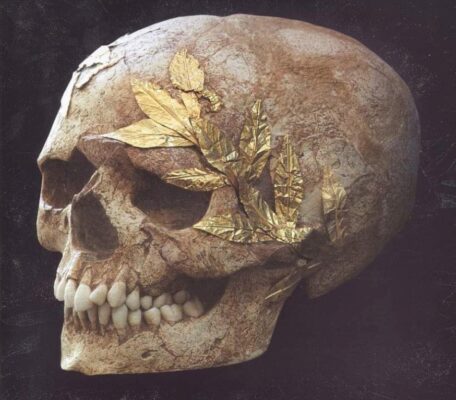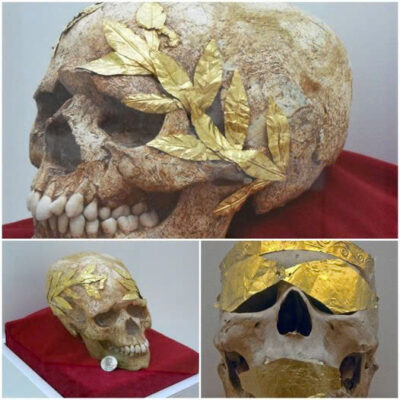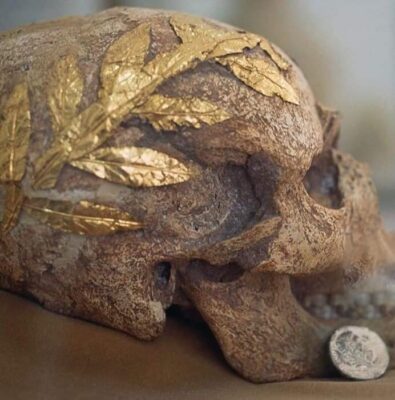Unearthed in Lato, an ancient city near modern-day Agios Nikolaos in Crete, Greece, the skull of a young athlete adorned with a golden laurel wreath is a remarkable artifact dating back to the 1st century AD. This relic provides a unique window into ancient Greek culture and the reverence held for athletic achievements. Now displayed at the Archaeological Museum of Agios Nikolaos, it captivates historians and visitors alike. Follow archeology.dulichvn.net to discover many hidden mysteries that have yet to be discovered.

The Discovery of a Remarkable Artifact
The discovery of this skull is a testament to the rich archaeological history of Crete and the significance of athleticism in ancient Greece.
1. The Ancient City of Lato
Lato was a prominent city in ancient Crete, known for its strategic location and cultural influence. Nestled in the hills overlooking the Gulf of Mirabello, it served as a hub for commerce, politics, and athletic endeavors during its peak.
2. The Skull and Its Significance
The skull, believed to belong to a young athlete, was unearthed alongside the golden laurel wreath. This discovery underscores the importance of athleticism and the honors bestowed upon athletes in ancient Greek society, where physical prowess was equated with divine favor.
3. Dating Back to the 1st Century AD
Carbon dating and contextual evidence place this artifact in the 1st century AD, a period that saw the continuation of Greek traditions even under Roman rule. This timeline enriches its historical importance as a bridge between two great civilizations.

The Skull of a Young Athlete: The Golden Laurel Wreath
The golden laurel wreath found with the skull is a key highlight, symbolizing honor, victory, and eternal recognition in ancient Greece.
1. The Craftsmanship of the Wreath
Made of finely beaten gold, the wreath demonstrates the exceptional skill of ancient Greek artisans. Its delicate leaves and realistic design reflect the high value placed on such ceremonial items.
2. A Tribute to Athletic Excellence
In ancient Greece, laurel wreaths were awarded to victors of athletic competitions, such as the Olympic Games. The presence of the wreath with the skull suggests that the individual was celebrated for their athletic achievements.
3. A Connection to Greek Mythology
The laurel tree held a sacred association with Apollo, the god of music, poetry, and athleticism. Golden laurel wreaths were often used in religious ceremonies, emphasizing the divine connection of the wearer.

Preserving History at the Archaeological Museum of Agios Nikolaos
Today, the skull and golden laurel wreath are preserved and displayed at the Archaeological Museum of Agios Nikolaos, inviting visitors to explore the legacy of ancient Greek culture.
1. The Museum’s Rich Collection
The Archaeological Museum of Agios Nikolaos houses an extensive array of artifacts from Crete’s history, including tools, pottery, and sculptures. The skull and wreath are among its most treasured exhibits.
2. Insights into Ancient Athleticism
The exhibit offers a fascinating look into the life of ancient athletes, their societal roles, and the honors they received. This artifact vividly illustrates the cultural and historical significance of athletic competitions in ancient Greece.
3. A Journey Through Time
Visitors to the museum can marvel at the craftsmanship of the wreath and the preserved skull, connecting them to a world where athletic glory was immortalized in gold.
See more: The Dragon Drink Container: A Masterpiece of Mythology and Craftsmanship
Conclusion
The skull of a young athlete adorned with a golden laurel wreath is a breathtaking discovery that speaks volumes about ancient Greek society. This relic not only celebrates athletic achievements but also reflects the values, artistry, and traditions of the time.
Displayed at the Archaeological Museum of Agios Nikolaos, this artifact continues to inspire and educate, bridging the gap between modern admirers and the rich heritage of ancient Greece. Make sure to add it to your list of must-visit historical sites in Crete for a profound journey through history!


CÁC TIN KHÁC
Mark Twain & Olivia Langdon: A 36-Year Love Story Filled with Laughter and Devotion
The Tollund Man: A 2,400-Year-Old Mystery Preserved in a Danish Bog
Skara Brae: Scotland’s Hidden Neolithic Village
Porta Nigra: The Hidden Depths of Trier’s Iconic Roman Gate